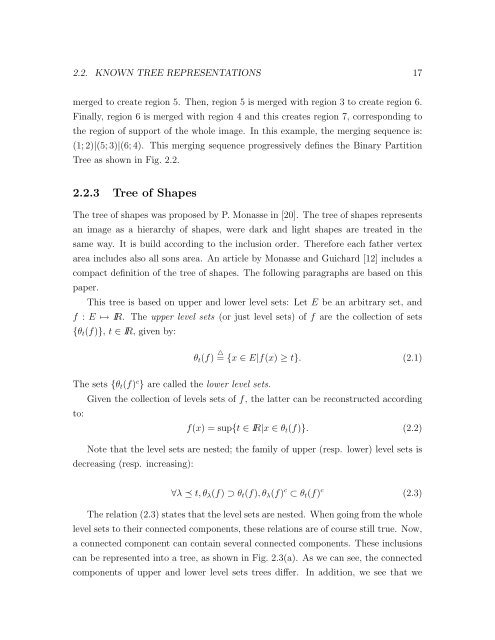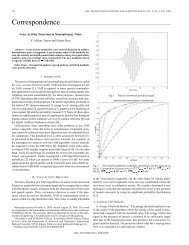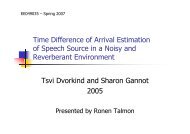Thesis (PDF) - Signal & Image Processing Lab
Thesis (PDF) - Signal & Image Processing Lab
Thesis (PDF) - Signal & Image Processing Lab
Create successful ePaper yourself
Turn your PDF publications into a flip-book with our unique Google optimized e-Paper software.
2.2. KNOWN TREE REPRESENTATIONS 17<br />
merged to create region 5. Then, region 5 is merged with region 3 to create region 6.<br />
Finally, region 6 is merged with region 4 and this creates region 7, corresponding to<br />
the region of support of the whole image. In this example, the merging sequence is:<br />
(1; 2)|(5; 3)|(6; 4). This merging sequence progressively defines the Binary Partition<br />
Tree as shown in Fig. 2.2.<br />
2.2.3 Tree of Shapes<br />
The tree of shapes was proposed by P. Monasse in [20]. The tree of shapes represents<br />
an image as a hierarchy of shapes, were dark and light shapes are treated in the<br />
same way. It is build according to the inclusion order. Therefore each father vertex<br />
area includes also all sons area. An article by Monasse and Guichard [12] includes a<br />
compact definition of the tree of shapes. The following paragraphs are based on this<br />
paper.<br />
This tree is based on upper and lower level sets: Let E be an arbitrary set, and<br />
f : E ↦→ IR. The upper level sets (or just level sets) of f are the collection of sets<br />
{θt(f)}, t ∈ IR, given by:<br />
The sets {θt(f) c } are called the lower level sets.<br />
to:<br />
θt(f) △ = {x ∈ E|f(x) ≥ t}. (2.1)<br />
Given the collection of levels sets of f, the latter can be reconstructed according<br />
f(x) = sup{t ∈ IR|x ∈ θt(f)}. (2.2)<br />
Note that the level sets are nested; the family of upper (resp. lower) level sets is<br />
decreasing (resp. increasing):<br />
∀λ � t, θλ(f) ⊃ θt(f), θλ(f) c ⊂ θt(f) c<br />
(2.3)<br />
The relation (2.3) states that the level sets are nested. When going from the whole<br />
level sets to their connected components, these relations are of course still true. Now,<br />
a connected component can contain several connected components. These inclusions<br />
can be represented into a tree, as shown in Fig. 2.3(a). As we can see, the connected<br />
components of upper and lower level sets trees differ. In addition, we see that we
















